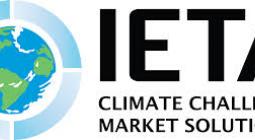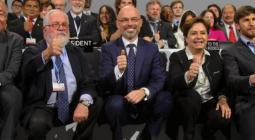IETA: Effective Article 6 trading rules could save up to $250 billion/yr for climate action by 2030, study finds.

NEW YORK, 24 September - International cooperation under a well-functioning Article 6 of the Paris Agreement could save as much as $250 billion per year by 2030, according to a new study. Experts believe that the savings could improve the likelihood of achieving the Paris climate protection goals.
The study was carried out by the International Emissions Trading Association and co-sponsored by Carbon Pricing Leadership Coalition,with the help of researchers and modellers from the University of Maryland. You can find a copy of the summary report here, and a copy of the full document here.
Reinvesting these savings in further emissions reductions could increase the potential for overall global reduction in greenhouse gases by around 5 billion tonnes a year in 2030, the study found, helping to close the ambition gap. Existing national commitments are currently estimated to achieve 9 billion tonnes in that timeframe, so Article 6 cooperation could enhance it by over 50%.
When coupled with natural climate solutions in lands and forests, the benefits become even greater – making an additional 9 billion tonnes of abatement feasible and doubling the effectiveness of the Paris Climate Agreement.
In the search for greater climate ambition, market cooperation and natural climate solutions are essential elements,” said Dirk Forrister, CEO of IETA. “The modelling shows how expensive ambitious targets can become if countries act in isolation – but if they work together to drive global market incentives and tap nature’s potential, the Paris goals come within reach.”
However, these astonishing outcomes rely on the adoption of a clear and transparent set of rules for international emissions trading, on one side, and on the inclusion of the use of Article 6 in countries’ Nationally Determined Contributions (NDCs) on the other.
“When international negotiators gather in Santiago, Chile in December, the top issue for decision this year is completion of the Article 6 rulebook,” said Cristobal De la Maza, Head of the Environment and Climate Division at the Ministry of Energy of Chile.
“This report shows the importance of getting it done well, so that countries can start working together more effectively and build confidence for raising ambitions.”
Nat Keohane, vice president for international climate at the Environmental Defense Fund, said: “These results, which are in line with independent analysis by EDF, show that international cooperation, including natural climate solutions, is critical to raising ambition."
"To cut emissions at the pace and scale that the science demands, we must harness the most powerful force we have — the power of markets. Countries can take an important step forward at COP25 in Santiago by agreeing on strong guidance under Article 6 of the Paris Agreement.”
Article 6 will guide the transfer and trade in emission reductions among nations, which will ultimately involve the private sector. At COP25 in Chile later this year, negotiators from more than 190 countries will be tasked with agreeing a set of rules to account for the trade in emissions reductions and to establish a UN body to govern a new Sustainable Development Mechanism for assessing and issuing carbon credits.
“A decision to operationalise Article 6 is crucial for a sustained, robust implementation of the Paris Agreement,” said Juan Pedro Searle, Article 6 Cluster Coordinator, Chilean negotiating team.
“Negotiators from every country and groups will have a unique opportunity at COP25 to leave a legacy to humankind: the adoption of the rules that will promote an unprecedented cooperation between parties in the fight against climate change. The invitation is open to make COP25 a successful event.”
Additional Background
Under the Paris Agreement, each nation has prepared a plan or NDC towards the overall goal of net zero carbon emissions by the second half of the century. The IETA/UMD modelling extrapolated current NDCs to the end of the century and ran them through four scenarios to estimate the total monetary value of Article 6 of the Paris Agreement.
If countries act in isolation, the models show a wide range of market prices emerging by 2030, from $0 in poor countries to $101 in Europe. But with effective market linkages, prices converge to a global average of $38 in 2030 whilst delivering the same level of climate protection.
“Net zero emissions means that trade must bring together natural and technological sinks with the remaining emitting sources, wherever they may be,” said said Stefano De Clara, IETA’s International Policy Director. “This can only be achieved if large scale trading systems emerge, and they must follow robust rules of transparency to instil business and public confidence.”
The calculations show that international cooperation through Article 6 could yield cost savings in the order of $249 billion per year by 2030, $345 billion per year by 2050 and $988 billion per year by 2100. These costs represent significant savings compared with a scenario in which nations do not cooperate on trading: costs are more than 60% lower in 2030, around 40% lower in 2050 and around 30% lower in 2100, the study found.
This in turn generated values for the global carbon market of about $167 billion in 2030, $347 billion in 2050, and $1.2 trillion in 2100. Even more importantly, the results show that all countries benefit, in terms of GDP growth, from Article 6 cooperation.
“This study illustrates how cooperation through carbon markets benefits all parties who join in,” said Angela Churie Kallhauge, Head of the CPLC. “It drives investment to those who have potential to reduce emissions more cost effectively than others.”
Interestingly, results show that developing effective policies to tap the land use sector's potential could further increase the economic and mitigation value of Article 6, increasing savings to $320 billion a year, and additional mitigation to 9 billion tonnes a year, in 2030. This clearly underlines the importance of Natural Climate Solutions coupled with an effective framework for international carbon markets.
“The cumulative additional mitigation enabled by perfect implementation of Article 6 over the course of the century exceeds 520 billion tonnes of CO2. [Reinvesting the savings into additional mitigation] enables 50 percent more mitigation compared to [the baseline scenario],” the report states.
“Our goal is to move this project forward to produce further results before COP25 and to continue the research effort in 2020,” said IETA’s Forrister. “There is a clear need for scientific research to examine potential implications of alternative rulesets and implementation pathways for Article 6”.
“Understanding the value of international cooperation under the Paris Agreement through Article 6 is extremely important to enable us to make a strong business case for stakeholders to prepare and engage in the development of international markets,” said the CPLC’s Kallhauge. “Such cooperation is important if we are to address concerns around competitiveness and the loss of productivity.”
IETA would like to acknowledge the following organisations for their support for the Article 6 modelling project: the Carbon Pricing Leadership Coalition, the University of Maryland, Chevron Corp., Conservation International, the Electric Power Research Institute (EPRI), the European Bank for Reconstruction and Development (EBRD), the Governments of Germany, Norway and the United Kingdom, the Institute for Global Environmental Strategies, Royal Dutch Shell plc and the Swedish Energy Agency.
About IETA
IETA is the voice of business on carbon markets around the world. Established in 1999, IETA's members include global leaders in the electricity, oil/gas, cement, aluminium, chemical, mining, technology, standards, verification, broking, trading, legal, finance, accounting and consulting industries.
24 September 2019
IETA




